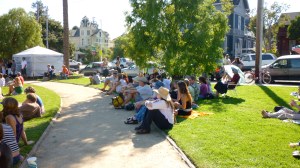by Julia Chiapelli
Leslie Johnson’s Tabula Rasa is anything but, though it wants us to remember that all of us started out that way.
Tabula Rasa is, of course, a clean slate. It’s also Johnson’s evening length collection of dance pieces and can be seen at the 418 Project—where she’s currently Artist in Residence—through October 10.
Still athletic, still breathtakingly energetic, Johnson has gathered this collection of pieces around a central idea, one that’s been whacked around as long as peddlers and swindlers have tried to separate people from their money: the effects of advertising.
What Johnson wants to hammer home, however, is how high the stakes have become: with multiple sources of media available and all of them bloated with advertising images, film clips, and logos, children are constantly inundated by messages from advertisers.
It’s a Brave New World, one that Johnson courageously attempts to expose—the Wizard has grown so large, so insidious; it’s like trying to trace the path of culpability in the BP oil disaster—if only to remind us what’s at stake: nothing less than our relationships and our sense of self.
If all this sounds a bit heady, be reassured: Tabula Rasa is a kick-ass antidote to anyone who has the impression, however slight, that our electronic media has spiraled out of control.
The evening begins and ends with that tried and true purveyor of fantasy: the television. As the dancers gather in the dark around the glowing TV screen—eyes glazed, bodies slack—Johnson makes her point: left unchecked, the glowing screen is adept at filling our subconscious with information.
It all seems harmless enough, can look cozy, in fact; the members of Johnson’s company Flex, lean and drape over one another, tucked safely into one another’s arms as they gaze raptly at the screen. But that, in itself, is part of Johnson’s premise: we have to peel away the layers of our, by now, well-accepted conventions and reveal the harm they are doing to our sense of play, our sense of wonder.
Throughout the evening, the Flex dancers display their unabashed dedication to Johnson as they engage in the blistering physicality that has become emblematic of her work. They careen into one another and are tossed, dragged, grabbed, and punched: in one piece, an assortment of clothing is used to wrap around dancers in a decidedly vicious-looking battle for goods.
Special mention needs to be made of Sara Russell and Melisa Wiley. In her solo performance, “Slim Hopes,” Russell artfully dances around the issue of eating orders, imbuing her jar of cookies with a quiet but sensually powerful angst and ardor. Melissa Wiley brings her delightfully passionate sense of accomplishment to “Housewife House Life,” a rollicking piece of commentary that’s a hilarious send-up of the 50s.
In addition, the all male members of the piece “Tough Guise” extend Johnson’s social commentary to the role of gender as she cracks open the double-sided coin of camaraderie and violence inherent to organized sports. Michael Miller, Nick Katzman, Hamid Martin, and Travis Johnson join Flex company stalwarts Evan Adler and Eli Weinberg in bringing all the bravado and thinly veiled aggression to the dance floor in a compellingly performed bit of dance.
Some dancers still need to watch their extensions and it’s a personal wish of mine to see Johnson bring her crushing physicality into quiet moments.
Far and above these assessments is the appreciation for both Johnson and her company as they continue to explore ideas and dance as venues for discovery and excellence.
You can still see Tabula Rasa on October 15, 16 at 8pm
and on the 17th at 6pm at The 418 Project, 418 Front Street, Santa Cruz.










